
Given that Dominic Roskrow is from the U.K., he might seem an unlikely advocate of American whiskey. “Yours is made to a vastly higher standard than Scotch,” says Dominic, author of The World’s Best Whiskies and editor of Whiskeria, Britain’s largest whiskey magazine. “There are rules governing what’s in the bottle, which we don’t have in Scotland. You have something really, really special. But makers of American whiskey haven’t been good at telling its story, which is amazing considering how loud and aggressive Americans can be.”
I decide to let this backhanded compliment slide, since Dominic has been such good company for the past few days and is so enthusiastic about our culture in general. We had met prior to our guided tour of America’s whiskey trail at a hotel bar in Nashville, Tennessee, where, to get in the spirit, we’d sampled several flights of Jack Daniel’s. We started with the Old No. 7, then Single Barrel and Gentleman Jack—and along the way discovered our common enthusiasm for quality spirits. While Dominic rhapsodized about America and the quality of its water and distilleries, we drifted figuratively from the deep smoky forests of Tennessee to the rolling, bluegrass-clad horse country of Kentucky, moving up the map like vapors of alcohol rising through a copper still.
Has America failed to tell its whiskey story? Well, someone’s getting the word out. Sales of super-premium American whiskies have doubled in five years while exports of U.S. spirits of all kinds have doubled over 10. And in recent years, the most storied brands have been joined by artisanal distillers from Florida to Alaska. There are now some 250 regional small-batch distillers compared with fewer than 50, 10 years ago.
“I don’t think there’s any question that we’re in bourbon’s heyday,” says Rich Ruth, former co-owner of Sidebar at Whiskey Row, a restaurant-bar in Louisville. “Ten years ago people would come into a bar and order vodka. Now we have people coming in and naming the brand of bourbon they want in a Manhattan.”

If that sounds like a contemporary trend, well, it may well be. But American whiskey is anything but trendy in the here-today-gone-tomorrow sense of the word. Indeed, whiskey (usually spelled without an “e” on the other side of the pond) has deep roots in American history. To tell the story, the Distilled Spirits Council mapped a route it calls the American Whiskey Trail that runs in an arc from Washington, D.C., through Pennsylvania and Kentucky into Tennessee, and Dominic and I and a few other passionate whiskey-philes set out to follow it.
The trail officially starts in Mount Vernon, Virginia, the home of America’s first president. George Washington was himself a whiskey maker and a whiskey drinker, but just to complicate things, during his presidency, he instituted the nation’s first tax on whiskey. In 1791, this triggered the Whiskey Rebellion in western Pennsylvania. The conflict pushed distillers west into Kentucky and Tennessee, where new state governments were giving settlers land grants and shielding them from the whiskey tax. It didn’t hurt that these new locales also had superb water thanks to a deep limestone bedrock that filtered out impurities.
“People say water’s water, but it’s not,” says John Lunn, the master distiller at George Dickel Whisky in Tullahoma, Tennessee, where we pick up the trail. (Dickel is one of the very few American manufacturers to follow the Scottish spelling.)
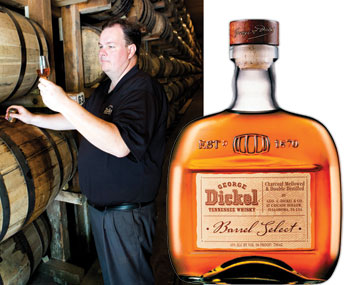
Sam Scrimm/George Dickel Whisky
As John walks us through the Dickel plant, describing the water and the mash, the stills and the barreling, it becomes clear that Dickel distills not just whiskey but a kind of heritage. The entire town of Tullahoma is a delightful throwback, set deep in a lush valley surrounded by a forest of the same sugar maples that Dickel uses for its charcoal. There’s a post office and a “Provisions & General Merchandise” store, and the distillery itself is housed in a building made of old wooden planks. Inside, you’ll find no banks of electronic monitoring systems controlling the process. “Computers can’t make good whiskey,” John says. “People make good whiskey.”
Next stop is Lynchburg, Tennessee, home of Jack Daniel’s. Its black label Old No. 7 is the world’s best-selling whiskey, its distillery the most visited. The company’s target market is wide, or as one executive puts it, “from the LDAs to the DNDs — the legal drinking age to the damn-near-dead.” About half is sold in America and half in 135 other countries.
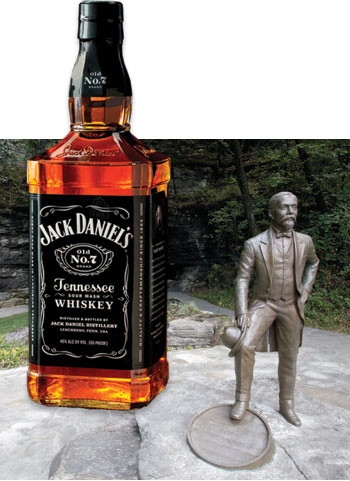
Photo courtesy of Jack Daniel’s
The Jack Daniel’s tour is crafted around its eponymous founder. Here, too, the water gets a lot of play, and our guide, attired in jeans and a cap, invites us to the mouth of a limestone cave where we gaze in like parents looking at newborns, except that while we all know where babies come from, no one has yet solved the hallowed mystery of the source of the water.
It’s a good story. So is the life of Jack, though it’s not as darkly peculiar as his death. He arrived at his office one day, couldn’t unlock his safe, and in his frustration put a boot to the heavy metal box. His injured foot became severely infected, and weeks after he kicked the safe, he kicked the bucket.
By the time we get to Lexington, Kentucky, the landscape has opened up, and we enter some of Kentucky’s most expensive real estate, with undulating fields anchored by horse paddocks and framed by plank fences and fieldstone walls.
They say the same limestone that makes for good whiskey also makes for strong bones, hence Kentucky’s famed racehorses. It seems fitting, then, that prior to our distillery tour, we head for the iconic Keeneland race track.
“Who are you taking?” Dominic asks as we step up to place bets.
“Voodoo Dancer to show,” I say. Voodoo is handicapped at 15:1. I’m handicapped by not knowing anything about horses. But I like the name.
Lo and behold, Voodoo shows.
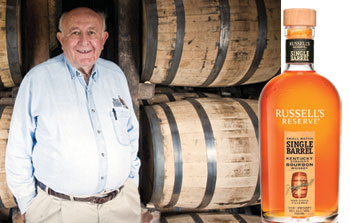
Photo courtesy of Wild Turkey
It’s like capturing magic in a bottle, and we look for more of it later at Wild Turkey. Master distiller Jimmy Russell, the grand old man of the Kentucky bourbon establishment, greets a group that has gathered at the distillery. His speech is all Kentucky — the speech of smart guys whose accent and manner of speaking is by itself a reason to visit. “More men drinks bourbon than women,” Jimmy says. “Lotta people puts it in coffee.”
Lotta people are also liking Wild Turkey’s higher-end cousins. After decades of producing just one whiskey, the company not long ago started rolling out a whole line. At the time of my visit, their Wild Turkey 81 had just won a double-gold medal in San Francisco. My favorite is Russell’s Reserve — named after Jimmy, of course — Single Barrel, which has a full but gentle mouth feel and rolls back into a spicy-sweet finish.
Jimmy invites more impressions. One fellow noses a snifter, swirling the amber nectar under his right nostril with one eye pinched. Like he’s doing an oral defense of a Ph.D. dissertation, “Macadamia,” he intones, and adds, “red apple.” I have no idea what he’s talking about, but what it does show is how bourbon is bringing people, a continuum from plain-spoken to downright effete, into one room.
If the big distillers are experiencing a revival, it’s the little guys, the small-batch artisanal distillers, who are nudging whiskey into the 21st century. They’re whiskey’s “Facebook generation,” since it’s social media that enabled them to reach an audience that previously would have been inaccessible. Many of these newcomers are making their mark by reviving heirloom recipes.
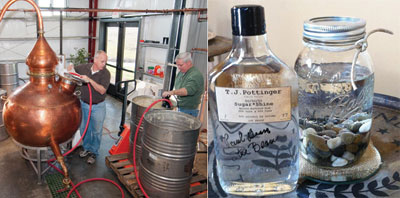
Photos courtesy of Limestone Branch Distillery
Take Steve and Paul Beam, brothers from a branch of the Beam family that left distilling, and one generation later wanted to get back in. They founded Limestone Branch Distillery and produce T.J. Pottinger’s Moon Shine Kentucky Corn Whiskey (88 percent corn, 12 percent malted barley) and Sugar Shine (uncooked mash of 50 percent heirloom white corn and 50 percent sugar cane). “We are reviving the art and craft of pre-Prohibition distilleries,” Steve says. “Prior to Prohibition there were thousands of small distilleries, some turned out rot gut, but the majority took great personal pride in turning out quality spirits. My great-grandfather grew his own grain, chose specific oak to make his own barrels, and was very particular about the entire process.”
In the morning we go to Bardstown, Kentucky, and eventually find the Talbott Tavern, a place that Dominic wanted to see, next to the Jailer’s Inn, now a B&B with the original iron bars on the windows and 30-inch-thick stone walls.
We enter and ask the way to the bar, but we’re too early. Perhaps it’s just as well, after all we’ve consumed over the past few days, that it’s still closed.
American Whiskey: A Primer

Bourbon can be made anywhere in the United States, but to be called by that name certain rules have to be observed. The mash, or mix of grains, has to be at least 51 percent corn, and it has to be casked in new charred oak barrels, from which the liquid, which goes in clear, leeches out color and flavors like vanillin and toffee. The corn mash itself is de-flavored. Other flavors come from malt barley and either rye or wheat, and the recipes, the fermenting process, and other factors that reflect the distiller’s style and intention will make whiskeys smoother or spicier or sweeter. (Tennessee whiskey goes through an additional step of being filtered through charcoal.)
The narrow list of approved ingredients means that American whiskey doesn’t have the bold and striking flavor varieties of Scotch. (An Islay Scotch is so different from a Highlands Scotch that it can be hard to know you’re in the same spirit category.) Instead, you get different levels of sweetness, spice, and smoothness. If some expert’s tasting notes can seem esoteric to less experienced drinkers, some flavor notes are easy enough to discern: vanilla, caramel, toffee, white pepper, and banana. And as with Scotch, it’s not necessary to drink it neat. Water can cool down a whiskey’s heat and draw out different flavors.
Interestingly, most American whiskeys don’t make age claims. When iconic master distiller Jimmy Russell of Wild Turkey says, “We don’t age it, we go by when it’s ready,” he is voicing an industry-wide tradition.
Todd Pitock has written for The Atlantic, ForbesLife, and The New York Times, among others.
Become a Saturday Evening Post member and enjoy unlimited access. Subscribe now
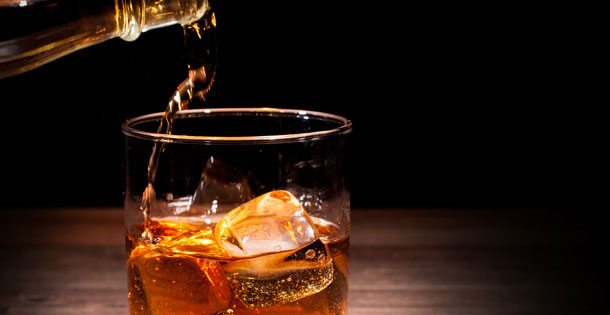



Comments
North Carolina has a massive history in whiskey and the various dealings. Look at the moonshiners from Wilkes County, NC in 1950s. Willie Clay Call was never caught running liquor and made more than any other in the area during his time. Now his recipe is going public with its legal brand of moonshine corn whiskey in 2014. The Call family whiskey heritage dates back to Dan Call who taught Jasper Newton Daniels how to make whiskey!! Where’s the love for NC?